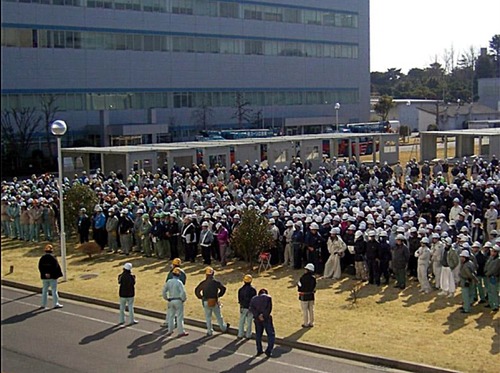May 30 2013
Ohno Disciple Led Earthquake Recovery in Semiconductor Plant| The Truth About Cars
See on Scoop.it – lean manufacturing
“After the March 11 monster earthquake and tsunami wiped out large parts of Japan, headlines focused on the near-meltdown of Fukushima. Recently, I learned that there was a strong likelihood of a worldwide economic meltdown, caused by a microchip factory 80 miles south of Fukushima. Here is the story of how the crisis was contained.
‘I was already retired when the earthquake came,’ remembers a Toyota official who requested that his name is not published. He is a seasoned production expert, one of the few alive who received personal training from Taiichi Ohno, the father of the Toyota production system. ‘I thought, let others handle the problem, but I was wrong.’ He was recalled and asked to spearhead the Toyota part of the reconstruction effort.”
While critics have often claimed that low inventories made Lean supply chains vulnerable to natural disasters, Toyota’s record in actual events says otherwise, in cases including, in the US, the Mississippi flood of 1993 and, in Japan, the Aisin Seiki fire of 1997 and now the Fukushima earhquake of 2011.
As it turns out, the combination of vigilance in logistics and relationships that make it possible to enlist the supply chain in rapid recovery works better than inventory. In the case of the Fukushima earthquake, more inventory would simply have meant more losses.
See on www.thetruthaboutcars.com

Oct 18 2013
When Bad Things Happen to Good Supply Chains | Industry Week
See on Scoop.it – lean manufacturing
“Any single failure anywhere in the supply chain can bring operations and profits to a standstill. From the 2011 tragedies of the Tōhoku earthquake and tsunami in Japan to last year’s devastating Hurricane Sandy closer to home, Mother Nature has a way of reminding us to reexamine catastrophe preparedness.
These events, and the tragic aftermath that follows, also serve to remind the insurance industry of the challenges in quantifying risk and accounting for exposure in an increasingly complex supply chain environment. As a result, risk managers are being asked new questions as insurance underwriters require them to seek information from a broader range of stakeholders within and outside of their organizations.”
The article is limited to a list of questions an insurer might ask about a supply chain, some of which cannot be pratically answered. The supply chain management literature often states the need to know your suppliers’ suppliers and your customers’ customers, but most companies don’t, and practically can’t.
After all, the point of buying from suppliers is to delegate responsibility for the whole upstream supply chain. If you have to worry about it all the way to mining raw materials out of the ground, you might as well make it all in-house from scratch, like at Ford’s River Rouge plant in the 1930s.
Asking the right questions is fine, but providing answers is better. Supply chain disruptions come in many degrees of severity and a variety of frequencies, from trucks delayed by traffic accidents to earthquakes and tsunamis.
You can, and should have preplanned responses to small, frequent disruptions. That may involve building some slack in milk run schedules, keeping small buffers of stocks, or having contingency plans for alternative transportation…
But you cannot practically have preplanned responses to all possible catastrophes. What you need is to monitor operations with vigilance to get early warnings, and develop relationships with your suppliers and customers that are strong enough that they come together and develop an ad-hoc, rapid response when disaster strikes.
This is the lesson I see in Toyota’s response to emergencies, from the Mississippi flood of 1993 to the Aisin Seiki fire of 1997 and the Fukushima earthquake of 2011.
See on www.industryweek.com
Share this:
Like this:
By Michel Baudin • Press clippings 3 • Tags: Disaster recovery, Lean, Supply chain, Toyota